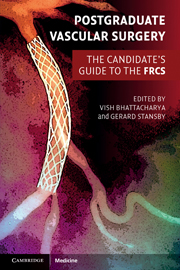Book contents
- Frontmatter
- Contents
- List of contributors
- Preface
- Section 1 Final FRCS vascular clinicals
- Section 2 Final FRCS vascular topics
- 1 Vascular risk factors and their management
- 2 Management of acute limb ischaemia
- 3 Chronic lower limb ischaemia, critical ischaemia and the diabetic foot
- 4 Endovascular and surgical options for peripheral revascularisation
- 5 Abdominal aortic aneurysms
- 6 Thoracic, thoracoabdominal and suprarenal aortic aneurysms
- 7 Aortic dissection
- 8 Popliteal artery aneurysms
- 9 Femoral artery aneurysms
- 10 Carotid, subclavian and vertebral disease
- 11 Diagnosis and management of thoracic outlet syndrome
- 12 Diagnosis and management of hyperhidrosis
- 13 Chronic mesenteric ischaemia
- 14 Acute ischaemic colitis
- 15 Vascular trauma
- 16 Indications and management of lower limb amputation
- 17 Leg swelling and lymphoedema
- 18 Varicose veins and chronic venous insufficiency
- 19 Management of deep vein thrombosis
- 20 Infection in vascular surgery
- 21 Vascular malformations
- 22 Vasospastic disorders and vasculitis
- 23 Critical care considerations and preoperative assessment for general and vascular surgery
- 24 Access surgery
- 25 Basic outline of solid organ transplantation
- Index
- References
6 - Thoracic, thoracoabdominal and suprarenal aortic aneurysms
- Frontmatter
- Contents
- List of contributors
- Preface
- Section 1 Final FRCS vascular clinicals
- Section 2 Final FRCS vascular topics
- 1 Vascular risk factors and their management
- 2 Management of acute limb ischaemia
- 3 Chronic lower limb ischaemia, critical ischaemia and the diabetic foot
- 4 Endovascular and surgical options for peripheral revascularisation
- 5 Abdominal aortic aneurysms
- 6 Thoracic, thoracoabdominal and suprarenal aortic aneurysms
- 7 Aortic dissection
- 8 Popliteal artery aneurysms
- 9 Femoral artery aneurysms
- 10 Carotid, subclavian and vertebral disease
- 11 Diagnosis and management of thoracic outlet syndrome
- 12 Diagnosis and management of hyperhidrosis
- 13 Chronic mesenteric ischaemia
- 14 Acute ischaemic colitis
- 15 Vascular trauma
- 16 Indications and management of lower limb amputation
- 17 Leg swelling and lymphoedema
- 18 Varicose veins and chronic venous insufficiency
- 19 Management of deep vein thrombosis
- 20 Infection in vascular surgery
- 21 Vascular malformations
- 22 Vasospastic disorders and vasculitis
- 23 Critical care considerations and preoperative assessment for general and vascular surgery
- 24 Access surgery
- 25 Basic outline of solid organ transplantation
- Index
- References
Summary
Key points
Aneurysm disease affects the thoracic aorta much less commonly than the infrarenal aorta
Most patients are asymptomatic but may have chest, back or abdominal pain
Diagnosis is on computed tomography (CT) angiogram and the Crawford classification is used to describe the extent of the aneurysm
Intervention is recommended if the aneurysm is >6 cm (or 5 cm in the presence of a connective tissue disorder or a family history of rupture)
Open surgery remains the standard treatment for complex suprarenal, thoracic and thoracoabdominal aneurysms
Specific complications incude risks of paraplegia and renal and visceral ischaemia
Endovascular repair is suitable for descending thoracic aneurysms
Epidemiology
The incidence of aneurysmal disease affecting the suprarenal aorta and the thoracic aorta is difficult to estimate since it is a condition that is usually asymptomatic and rupture, which is often rapidly fatal, is commonly misattributed to other causes such as myocardial infarction or pulmonary embolism. The incidence is approximately 6 per 100,000 people per year. Males are affected about twice as commonly as females but interestingly the gender difference is less than for infrarenal aortic aneurysms, where the ratio is up to 7:1.
Natural history data are scarce, typically involving retrospective observation of patients not fit for open repair. In a series of 1600 cases the rupture risk for a 6 cm aneurysm of the thoracic aorta was 3.6% per year and for the composite endpoint of rupture/dissection/death the annual risk was 14.1%.
- Type
- Chapter
- Information
- Postgraduate Vascular SurgeryThe Candidate's Guide to the FRCS, pp. 99 - 107Publisher: Cambridge University PressPrint publication year: 2011

